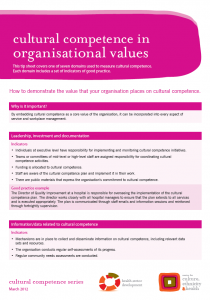How Can We Help?
Why is it important?
By embedding cultural competence as a core value of the organisation, it can be incorporated into every aspect of service and workplace management.
Leadership, investment and documentation
Indicators
- Individuals at executive level have responsibility for implementing and monitoring cultural competence initiatives.
- Teams or committees of mid-level or high-level staff are assigned responsibility for coordinating cultural competence activities.
- Funding is allocated to cultural competence.
- Staff are aware of the cultural competence plan and implement it in their work.
- There are public materials that express the organisation’s commitment to cultural competence.
Good practice examples
The Director of Quality Improvement at a hospital is responsible for overseeing the implementation of the cultural competence plan. The director works closely with all hospital managers to ensure that the plan extends to all services and is executed appropriately. The plan is communicated through staff emails and information sessions and reinforced through fortnightly supervision.
Information/data related to cultural competence
Indicators
- Mechanisms are in place to collect and disseminate information on cultural competence, including relevant data sets and resources.
- The organisation conducts regular self-assessments of its progress.
- Regular community needs assessments are conducted.
Good practice example
The cultural diversity coordinator at a community health centre conducts an annual self-assessment workshop to review progress on the centre’s cultural competence plan. Managers and staff discuss their work with culturally diverse clients and the process used to support this work, indentifying strengths and areas for improvement.
Organisational flexibility
Indicator
Administration and service delivery adaptations are tailored to the population of the service area, including adaptations to improve access to care.
Good practice
example A rural health service maps presenting conditions against the demographic profile of its clients. Certain conditions, such as gestational diabetes, are found to be more prevalent in particular cultural groups. As a result the service develops a campaign to raise awareness of these conditions. Representatives of target groups are engaged in developing culturally appropriate resources and education strategies.
Reference
This tip sheet is based on Indicators of Cultural Competence in Health Care Delivery Organisations: An Organisational Cultural Competence Assessment Profile , prepared by the Lewin Group Inc. under contract with the USA Department of Health and Human Services (2002).
English Resource:
Last reviewed:
Links to the seven domains of the cultural competence framework
The eight tip sheets in this series cover different domains. These domains are interrelated and provide a comprehensive framework for assessing and improving cultural competence.
A framework for Cultural Competence
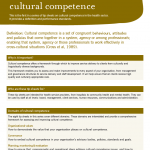
This is the first in a series of tip sheets on cultural competence in the health sector. It provides a definition and performance standards.
Governance

How to embed cultural competence in your organisation’s advisory bodies, policies, standards and goals.
Planning, monitoring & evaluation

How to ensure that programmatic and operational plans address cultural competence issues, and how to track and assess your organisation’s progress.
Communications
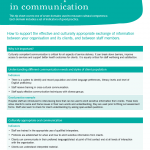
How to support the effective and culturally appropriate exchange of information between your organisation and its clients, and between staff members.
Staff development
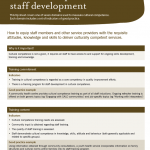
How to equip staff and service providers with the attitudes, knowledge and skills needed to deliver culturally competent services.
Organisational infrastructure
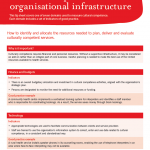
How to identify and allocate the resources needed to plan, deliver and evaluate culturally competent services.
Services & intervention
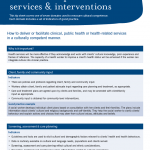
How to deliver or facilitate clinical, public health or health-related services in a culturally competent manner.
Organisational values
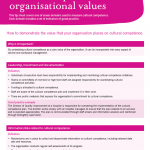
How to demonstrate the value that your organisation places on cultural competence.
Resource Type: Tip/Fact Sheets

